
The spider species Araneus diadematus is commonly called the European garden spider, cross orbweaver, diadem spider, orangie, cross spider, and crowned orb weaver. It is sometimes called the pumpkin spider, although this name is also used for a different species, Araneus marmoreus. It is an orb-weaver spider found in Europe, where it is native, and North America, where it was introduced.
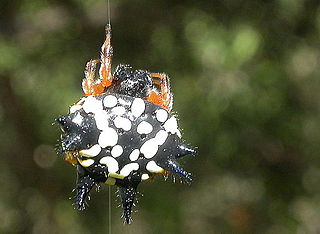
Austracantha is a genus of spider with a single species, Austracantha minax, commonly known as the jewel spider or the Christmas spider. It is a member of the family Araneidae and is endemic to Australia. They are relatively small spiders, reaching a maximum total body length of only around 12 mm (0.47 in) for females, and 5 mm (0.20 in) for males. Their abdomen has six distinctive projections ("spines") that makes them easy to identify. They are predominantly a shiny black, with variable white, yellow, and orange patterns. Melanistic forms also occur during autumn. They are facultatively gregarious, and can be found in large aggregations of overlapping orb webs. They feed on small flying insects that get entangled in their webs. They are harmless to humans, though the webs can be a nuisance for bushwalkers. They are most abundant during the summer months.

The spider species Tegenaria domestica, commonly known as the barn funnel weaver in North America and the domestic house spider in Europe, is a member of the funnel-web family Agelenidae.

Araneus quadratus, the four-spot orb-weaver, is a common orb-weaver spider found in Europe and Central Asia, and as far as the Kamchatka Peninsula and Japan. Females can reach 17 mm in length, especially when gravid, with males around half that. They are quite variable in appearance, ranging from brown to bright orange or green, but they always have the characteristic four white spots on the abdomen. The darker color morphs are easier to identify, due to the contrast between the white spots and the rest of the body. The legs are sometimes brightly striped.

Araneus is a genus of common orb-weaving spiders. It includes about 650 species, among which are the European garden spider and the barn spider. The genus was erected by Carl Alexander Clerck in 1757.
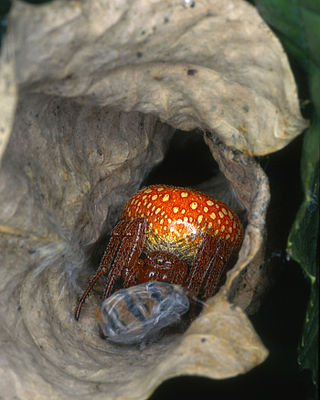
Araneus alsine, the strawberry spider or orange wheelweaving spider, is a species of the orb-weaving spider family, Araneidae.

The barn spider is a common orb-weaver spider native to North America. They are around three-quarters of an inch (20 mm) in length and are usually yellow and brown in color. They often construct their webs in wooden human structures, hence their common name. The species is notable for being the basis for the character Charlotte in the book Charlotte's Web by American writer E. B. White.
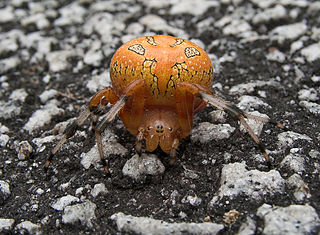
Araneus marmoreus, commonly called the marbled orbweaver, is a species of spider belonging to the family Araneidae. It is sometimes also called the pumpkin spider from the resemblance of the female's inflated abdomen to an orange pumpkin. It has a Holarctic distribution.
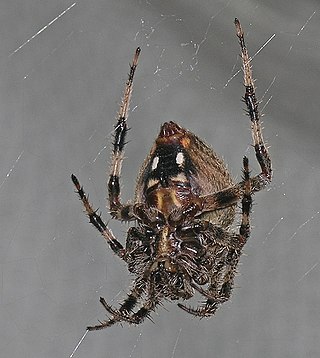
Neoscona crucifera is an orb-weaver spider in the family Araneidae. It is found in the United States from Maine to Florida in the east, to Minnesota in the Midwest, to Arizona in the southwest, southern California coastal communities and in Mexico. Its common names include Hentz orbweaver, spotted orbweaver, and barn spider. The name "barn spider" is also commonly used for a different spider, Araneus cavaticus.

Neoscona domiciliorum, commonly known as the spotted orbweaver or redfemured spotted orbweaver, is a spider in the family Araneidae. The specific epithet domiciliorum means "of dwellings" in Latin and refers to the fact that this species is often found living on buildings. Their bites are not known to cause serious harm in humans.

Araneus mitificus, commonly known as the kidney garden spider or pale orb weaver is a species of orb-weaver spider found in South, East, and Southeast Asia.
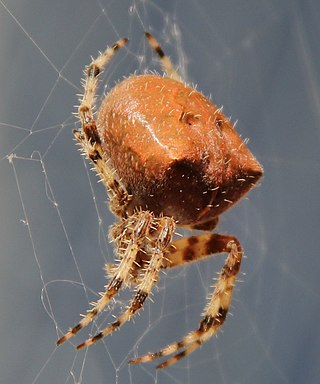
Araneus gemmoides, commonly known as the jewel spider and cat-faced spider, is a common, outdoor, orb-weaver spider found in Canada and the USA. It is considered harmless and has a low-toxicity venom. A. gemmoides is a useful natural predator for insects.

The spider species Plebs eburnus is commonly referred to as the eastern grass orb-weaver or the eastern bush orb-weaver, and sometimes more simply as the bush orb-weaver. It is an orb-weaver spider from the family Araneidae endemic to Australia. It is a very common spider with distinctive white markings, which give it the species name eburnus pertaining to ivory. It is found in scrub and tall grasses where the female constructs a vertical web usually no more than 2 metres from the ground, and stays there day and night. The web of some of these spiders has been seen to be decorated with nearly vertical stabilimentum. The stabilimentum of the related P.cyphoxis is usually observed vertical.
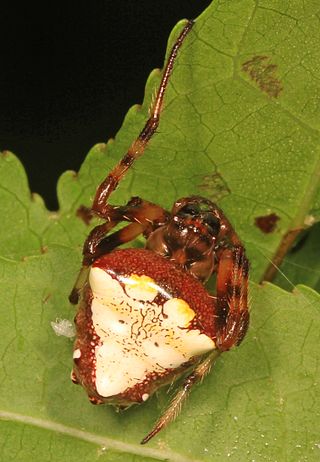
Verrucosa arenata, also known as the triangle orb weaver, arrowhead spider, and arrowhead orbweaver, is a species of orb-weaver spider found across North America. It is one of the few known large orb-weaver spiders that sits facing upwards in its web. Unlike most orb-weavers, which have bulbous abdomens, V. arenata has an abdomen that is pointy and triangular, shaped like the tip of an arrow. In females, the abdomen is colored white or yellow. Additionally, V. arenata uses reeling behavior in order to capture its prey, as its webs are stronger than that of most other orb weavers. The genus name Verrucosa means "warty" in Latin, referring to the small wartlike bumps on the spider's abdomen, while the specific epithet arenata derives from Latin arena, meaning "sand".

Araneus bicentenarius, the giant lichen orbweaver, is a species of orb weaver in the family Araneidae. It is found in the USA and Canada.

Araneus juniperi is a species of spider in the orb weaver family (Araneidae). It is found in the US and Canada.

Araniella displicata, the sixspotted orbweaver, is a species of orb weaver in the spider family Araneidae. It is found in North America, Europe, a range from Russia to Kazakhstan, China, Korea, and Japan.

Araneus guttulatus, is a species of orb weaver in the spider family Araneidae. It is found in the Eastern United States, such as Oklahoma and Eastern Canada. The species usually has green legs and cephalothorax whilst the abdomen is often reddish-brown with white marks.

Salsa is an Australasian genus of orb-weaver spiders.

Salsa fuliginata, commonly known as the sooty orbweaver, is a orb-weaver spider in the genus Salsa. The species is found throughout southeastern Australia and New Zealand.





















